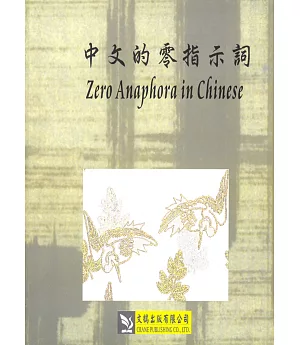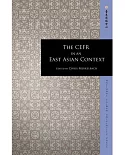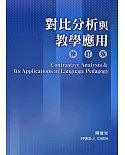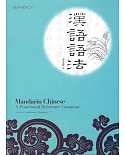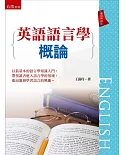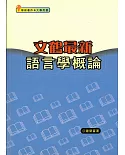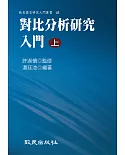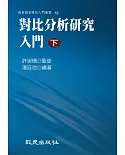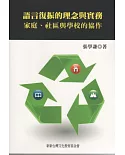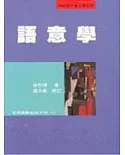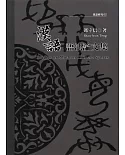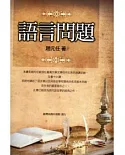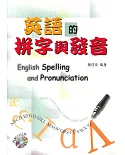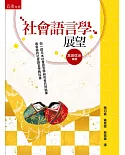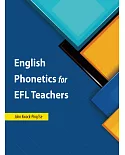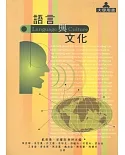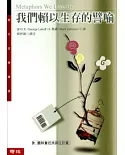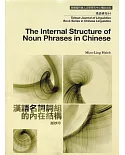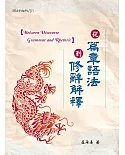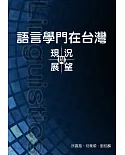內容簡介
This thesis consists of five chapters. Chapter 1 is the introductory chapter where the issues studies in this thesis, namely, that of recovering the zero anaphoric subjects and realizing or
translating of the zero anaphoric subjects into English is introduced. Chapter 2 review the literature on zero anaphors in Chinese. Chapter 3 discusses the principles involved in recovering the
zero anaphoric subjects in Chinese narrative. Chapter 4 discusses the different ways in which the zero anaphoric subjects are realized in English translation.Chapter 5 summarizes the findings
in this dissertation.
目錄
TABLE OF CONTENTS
CHAPTER 1 INTRODUCTION
1.0 Introduction
1.1 Recovery of Zero Anaphoric Subjects
1.2 Translation of Zero Anaphoric Subjects
1.3 Data of Chinese Text and English Translations
1.4 Significance and Implications of Research
1.5 Thesis Outline
CHAPTER 2 LITERATURE REVIEW ON THE RECOVERY AND TRANSLA TION OF ZERO ANAPHORIC SUBJECTS IN CHINESE
2.0 Introduction
2.1 Literature on the Recovery of Zero Anaphoric Subjects in Chinese
2.2 Literature on the Translation of Zero Anaphoric Subjects in Chinese
2.2.1 Literature on Chinese Translation Studies
2.2.2 Literature on Wester Translation Studies
CHAPTER 3 PRINCIPLES TO RECOVER REFERENTS OF ZERO SUBJECTS
3.0 Introduction
3.1 Defining the Issue
3.2 Discourse Structure for Referent Recovery
3.3 Conventions and Notations for Examples Used
3.4 Principles for Referent Recovery
3.5 Recency Principle
3.5.1 Perception Verbs
3.5.2 Semantic Matching
3.5.3 Object of Perception Verbs
3.5.4 Related Action
3.5.5 Running Narrative
3.5.6 Summary
3.6 Opening Principle
3.6.1 Consequence Markers
3.6.2 Emotives
3.6.3 Ordinals
3.6.4 Connectives
3.6.5 Summary
3.7 Contextual Principle
3.7.1 Dominance Factor
3.7.2 Role Constraint
3.7.3 Role Expectation
3.7.4 Relationship Between Characters
3.7.5 Summary
3.8 Conclusion
CHAPTER 4 TRANSLATION OF ZERO AN APHORIC SUBJECTS INTO ENGLISH
4.0 Introduction
4.1 Defining the Issue
4.2 Unit of Translation and Organization
4.3 Techniques of Translating Zero Subjects in Chinese into English
4.3.1 Specification
4.3.1.1 Proper Nouns
4.3.1.2 New Noun Phrases
4.3.1.3 Pronouns
4.3.2 Non-Specification
4.3.2.1 Passive Voice
4.3.2.2 Existential Subject
4.3.3 Pronominal Reference
4.3.3.1 Third Person Pronoun and Possessive Pronoun
4.3.3.2 Relative Pro
4.3.4 Connection
4.3.4.1 Coordination
4.3.4.2 Subordination
4.3.4.2.1 Non-Finite Clauses
4.3.4.2.2 Correlative Subordinators
4.3.4.2.3 Prepositional Phrases
4.3.5 Rearrangement
4.3.5.1 Change of Order
4.3.5.2 Rephrasing
4.3.5.3Change of Refere
4.3.5.4 Discourse Reference
4.3.6 Editing
4.3.6.1 Addition
4.3.6.2 Omission
4.3.6.3 Form
4.4 Conclusion
CHAPTER 5 CONCLUSION
REFERENCES
APPENDIX NAMES OF CHAR ACTERS IN HOUGLOUMENG
VITA
CHAPTER 1 INTRODUCTION
1.0 Introduction
1.1 Recovery of Zero Anaphoric Subjects
1.2 Translation of Zero Anaphoric Subjects
1.3 Data of Chinese Text and English Translations
1.4 Significance and Implications of Research
1.5 Thesis Outline
CHAPTER 2 LITERATURE REVIEW ON THE RECOVERY AND TRANSLA TION OF ZERO ANAPHORIC SUBJECTS IN CHINESE
2.0 Introduction
2.1 Literature on the Recovery of Zero Anaphoric Subjects in Chinese
2.2 Literature on the Translation of Zero Anaphoric Subjects in Chinese
2.2.1 Literature on Chinese Translation Studies
2.2.2 Literature on Wester Translation Studies
CHAPTER 3 PRINCIPLES TO RECOVER REFERENTS OF ZERO SUBJECTS
3.0 Introduction
3.1 Defining the Issue
3.2 Discourse Structure for Referent Recovery
3.3 Conventions and Notations for Examples Used
3.4 Principles for Referent Recovery
3.5 Recency Principle
3.5.1 Perception Verbs
3.5.2 Semantic Matching
3.5.3 Object of Perception Verbs
3.5.4 Related Action
3.5.5 Running Narrative
3.5.6 Summary
3.6 Opening Principle
3.6.1 Consequence Markers
3.6.2 Emotives
3.6.3 Ordinals
3.6.4 Connectives
3.6.5 Summary
3.7 Contextual Principle
3.7.1 Dominance Factor
3.7.2 Role Constraint
3.7.3 Role Expectation
3.7.4 Relationship Between Characters
3.7.5 Summary
3.8 Conclusion
CHAPTER 4 TRANSLATION OF ZERO AN APHORIC SUBJECTS INTO ENGLISH
4.0 Introduction
4.1 Defining the Issue
4.2 Unit of Translation and Organization
4.3 Techniques of Translating Zero Subjects in Chinese into English
4.3.1 Specification
4.3.1.1 Proper Nouns
4.3.1.2 New Noun Phrases
4.3.1.3 Pronouns
4.3.2 Non-Specification
4.3.2.1 Passive Voice
4.3.2.2 Existential Subject
4.3.3 Pronominal Reference
4.3.3.1 Third Person Pronoun and Possessive Pronoun
4.3.3.2 Relative Pro
4.3.4 Connection
4.3.4.1 Coordination
4.3.4.2 Subordination
4.3.4.2.1 Non-Finite Clauses
4.3.4.2.2 Correlative Subordinators
4.3.4.2.3 Prepositional Phrases
4.3.5 Rearrangement
4.3.5.1 Change of Order
4.3.5.2 Rephrasing
4.3.5.3Change of Refere
4.3.5.4 Discourse Reference
4.3.6 Editing
4.3.6.1 Addition
4.3.6.2 Omission
4.3.6.3 Form
4.4 Conclusion
CHAPTER 5 CONCLUSION
REFERENCES
APPENDIX NAMES OF CHAR ACTERS IN HOUGLOUMENG
VITA
序
Preface
In reading Chinese prose and novels, one often comes across long sentences with several clauses. More often than not, these clauses do not have subjects; one has to trace which subjects the predicates are related to. Although this process is done almost subconsciously by Chinese readers. We often take for granted how these subjects are being ascertained. This book sets out to investigate how these subjects are being traced and how they are realized in the English translations.
These zero subjects are also anaphoric in the sense that they can be traced to their respective subjects. Hence the term zero anaphoric subjects. The data used for this book is the classic Chinese novel Hongloumeng Dream of the Red Chamber which is known to be a representative of the written Chinese language even up till this day.
The first part of the book deals with the question of how zero subjects in Chinese are recovered. In other words, how does one know whom or what the predicates are referring to if the subject is zero. In more complex situations, a change of reference can even occur throughout the zero subject clauses. If this happens, how is one to know where it has occurred and to whom the reference has switched?
The second part of the book explores the different ways in which these zero subjects are translated in both David Hawkes' The Story of the Stone and Gladys Yang and Yang Hsien-yi's A Dream of the Red Mansions. Since subjects are present in most English sentences, it would be interesting - contrastive wise - to see how such a difference is bridged in translation.
Methodologically, the first part of the book involves discourse analysis in recovering the zero subjects, the second part is a contrastive analysis of this phenomenon between English and Chinese. It is hoped that such a study will show that where grammar stops at sentence level, discourse analysis is needed to explore issues that go beyond the immediate clause in languages such as Chinese where the boundary of sentence is often unclear. At the same time, contrasting Chinese and English will also enable readers to appreciate the differences in the two languages in a more concrete way. This is thus a study that combines discourse analysis and contrastive analysis.
Many thanks to Chung Raung-fu, my former colleague at the University of Illinois Urbana- Champaign for his help and encouragement. I am also very grateful to Crane Publishing Co. who has made this book a reality. This book is dedicated with love to my husband Sen and my sons Jedd and Tedd.
Unless the Lord builds the house, its builders labor in vain. Ps 127:1
In reading Chinese prose and novels, one often comes across long sentences with several clauses. More often than not, these clauses do not have subjects; one has to trace which subjects the predicates are related to. Although this process is done almost subconsciously by Chinese readers. We often take for granted how these subjects are being ascertained. This book sets out to investigate how these subjects are being traced and how they are realized in the English translations.
These zero subjects are also anaphoric in the sense that they can be traced to their respective subjects. Hence the term zero anaphoric subjects. The data used for this book is the classic Chinese novel Hongloumeng Dream of the Red Chamber which is known to be a representative of the written Chinese language even up till this day.
The first part of the book deals with the question of how zero subjects in Chinese are recovered. In other words, how does one know whom or what the predicates are referring to if the subject is zero. In more complex situations, a change of reference can even occur throughout the zero subject clauses. If this happens, how is one to know where it has occurred and to whom the reference has switched?
The second part of the book explores the different ways in which these zero subjects are translated in both David Hawkes' The Story of the Stone and Gladys Yang and Yang Hsien-yi's A Dream of the Red Mansions. Since subjects are present in most English sentences, it would be interesting - contrastive wise - to see how such a difference is bridged in translation.
Methodologically, the first part of the book involves discourse analysis in recovering the zero subjects, the second part is a contrastive analysis of this phenomenon between English and Chinese. It is hoped that such a study will show that where grammar stops at sentence level, discourse analysis is needed to explore issues that go beyond the immediate clause in languages such as Chinese where the boundary of sentence is often unclear. At the same time, contrasting Chinese and English will also enable readers to appreciate the differences in the two languages in a more concrete way. This is thus a study that combines discourse analysis and contrastive analysis.
Many thanks to Chung Raung-fu, my former colleague at the University of Illinois Urbana- Champaign for his help and encouragement. I am also very grateful to Crane Publishing Co. who has made this book a reality. This book is dedicated with love to my husband Sen and my sons Jedd and Tedd.
Unless the Lord builds the house, its builders labor in vain. Ps 127:1
網路書店
類別
折扣
價格
-
新書9折$315

